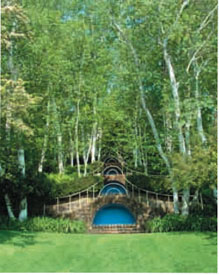Moderne (Art Deco) Style 1920-1941
ArchitectureAt times referred to as the zig-zag style, these buildings are typically stucco and glass block with rounded corners, round windows and horizontal grooves to emphasize a streamlined look. Deco buildings have no visually distinct foundation.
 | Fig. 48 |
Fletcher Steele is the most influential American landscape designer in the 1920s-1930s, transitioning from the Beaux Arts to the Arts & Crafts style, and finally to Modernism. He admires French Art Deco garden experiments, after seeing the Art Deco Exhibition and cubist gardens in Paris in 1925 that utilize mirrors, concrete and colored gravel. His first garden in this style is for Helen Ellwanger, using the new revolutionary material, concrete. It forms a bold diagonal from curved steps to an intricately patterned terrace (GardenVisit, 2007).Steele uses geometry, setting off curved against straight lines, and relates curved lines to the site contours (Fig. 47). His most famous project is The Blue Steps, (Fig. 48) at Naumkeag, where the light blue painted concrete steps cascade into a birch wood.
 | Fig. 49 |
Art Deco gardens designed by other designers are more minimal and formal in comparison. Lawn is the dominant garden element, setting off the house form. It is dotted with clipped evergreen trees and shrubs, and modern sculptures of the era. In Europe, Renaissance objects, such as obelisks, are also used. If hedges are planted, they are trimmed and placed along property lines, away from the house.
